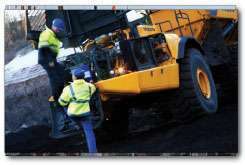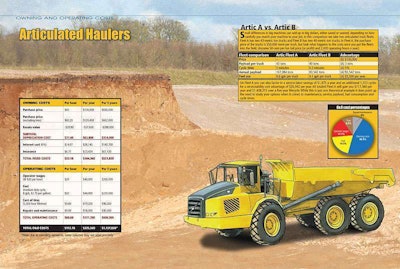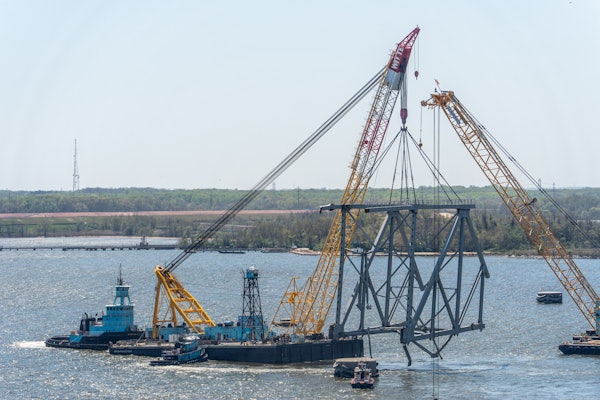Articulated Trucks
Being penny-wise on acquisition costs may create pound-foolish results.
By Tom Jackson
 Paying attention to serviceability, fuel consumption and payload yields big dividends on high volume earthmovers.
Paying attention to serviceability, fuel consumption and payload yields big dividends on high volume earthmovers.The articulated hauler has gained in popularity in the last two decades as a highly productive earthmoving tool, proving its worth against other high volume earthmoving methods and machines, such as rigid axle dump trucks, dozers, and self-propelled and towed scrapers.
Choosing the right machines and methods for this kind of mass excavation comes down to carefully detailing owning and operating costs and then applying those figures to the amount of material (tons or cubic yards) you can move in an hour. In this article we’ll focus on just the machine O&O costs, since a discussion of productivity requires an analysis of soil types, site conditions and support machines – more variables than we could detail in these four pages.
Keep in mind that the numbers we present here are ballpark estimates for discussion purposes only. To get a more accurate and detailed estimate of your costs consult with an equipment dealer. Once you’ve calculated your costs on the articulated truck, you’ll need to do the same for the support machines and compare different combinations.
For our study machine we chose a 43-metric-ton Volvo A40E articulated hauler. Blaine Pressley, senior segment manager for Volvo Construction Equipment North America, says a very general estimate for the lifecycle on this machine would be 12,000 to 15,000 hours, but in lighter applications some customers have gone as far as 30,000 hours. “It is up to the owner as to how much money they are willing to spend to keep the vehicle running,” he says. “The point at which the operating costs exceed the owning costs is viewed by many as the economic life of the machine and thus the effective life cycle.”
One key O&O variable that owners have control over is the quality of their preventive maintenance, Pressley says. Using cheaper consumables may save money short term but can result in more repairs and shorter component lifespan over the long term. Operator training and skill also plays a part in component life. Appropriate use of traction control systems and longitudinal and differential lock functions can make a tremendous difference in component life, fuel use, tire wear and cycle times.
Before we get into the numbers in the charts on page 20, here is a broader discussion of the variables behind the numbers. Keep in mind these are general estimates. Volvo and many other equipment manufacturers have proprietary owning and operating cost software programs available through their dealers that can help move you closer to an accurate number for your specific needs. These O&O software programs are always a good idea for any machine, but for high-volume earthmovers like artics, they are a must. Detailed software programs can ask the questions many contractors tend to overlook and get you closer to a true total cost of ownership value that fully accounts for things like financing, service and maintenance, and resale value.
Also ask about site simulation software that can help you select the best match of equipment and maximize productivity. Using site simulation software and dealer can come to your site and help you plot grades, curves and truck routes, Pressley says. You want to have the right number of haulers for the site and the right number of passes to fill the truck to insure the best possible productivity. And as with the O&O costs, small differences add up to big dollars here.
OWNING COSTS
Purchase price
The typical price for a new machine in the 40-ton category prices ranges from around $500,000 to $670,000. Keep in mind this is the suggested list price. Consult a dealer for an actual quote. The value of a trade-in machine, or a package deal involving additional machines may have an impact as well. You may want to compare the purchase price against buying a low-hour used machine or a refurbished machine. “The normal refurbishment cost can be somewhere between 30 to 45 percent of the price of a new machine,” Pressley says. And while most people tend to focus on the purchase price, it is always a small part of the total O&O costs. See our charts labeled “Artic A vs. Artic B,” on page 21.
Finance/interest cost
The average APR is around 6 percent for this size machine.
Insurance
Depending on your provider, expect to pay about 2 percent of the purchase price on an annual basis.
Resale price/residual value
The reputation of the brand, number of hours on the engine and major components, condition of the machine, quality of maintenance and local market dynamics all play a role in setting the resale price. In general, artics in the 40-ton category lose somewhere in the range of 10 to 15 percent of their residual value per year, says Pressley.
OPERATING COSTS
Fuel use
Varies with application, steepness of terrain, weight of loads. As a general rule, a light application will use around 6 gph, a medium application uses about 8.5 gph and a heavy application may consume approximately 12.5 gph. These figures vary between manufacturers and it pays to do your homework as a half gallon per hour difference can make a huge cost difference in a short period of time.
Tire lifecycle and cost
Again application and usage determine the life of your tires. Expect a range between 3,000 and 5,000 hours. Pressley says Volvo’s manufacturer’s list price is around $48,000 for a set of six tires for this artic. Note that maintaining correct tire pressure is critical for getting the longest life possible out of a tire. (In most O&O models the tire cost is subtracted from the purchase price [as we have done in the chart on page 20] in order to more clearly represent tires as an operating, rather than an owning cost.)
Preventive maintenance
Each manufacturer will have slightly different schedules and parameters and as a result the costs and service intervals may vary considerably. This is another reason you should use the dealer’s cost estimating programs. As a very rough estimate you could assume an average cost of about $4 per operating hour over the course of a 12,000 to 15,000 hour lifecycle. Pressley says to note that good preventive maintenance isn’t just lubes, fluids and filters but also includes:
• Cleaning
• Oil analysis
• Inspections
• Testing
• Sampling
• Measurements
• Adjustments
• Repairs
• Proper documentation.
“Good preventive maintenance is usually the single most important and controllable factor the customer has in reducing owning and operating costs,” he says. “It’s the principal of pay now or pay later, and the up-front costs required for good PM is minimal compared to the cost of a machine that’s down due to failure.”
Repairs
A ballpark estimate amortized over a 12,000- to 15,000-hour lifecycle would fall in the $5 an hour range.
Operator wages
Determined by company policy and regional trends.
Additional
Articulated trucks, their drivelines and transmissions have become more sophisticated over the past few years in order to better help you conserve fuel, increase productivity and reduce tire and component wear, says Pressley. Learning and comparing the competitive features of each brand and then training your operators to take advantage of these features can produce significant cost savings and productivity gains. EW











